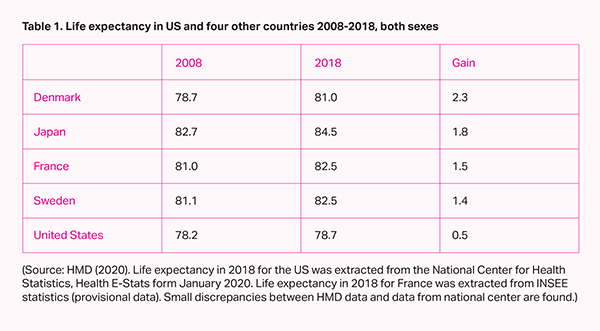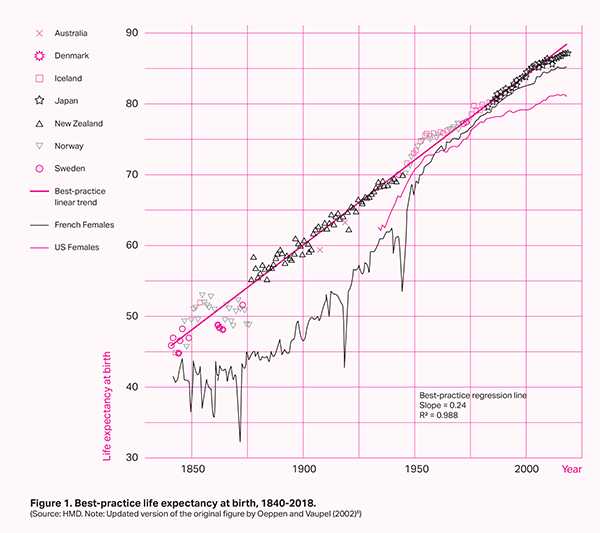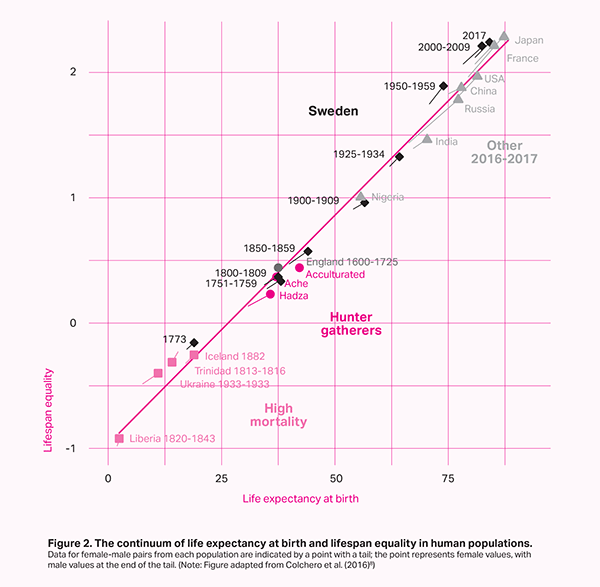
By Marie-Pier Bergeron-Boucher, Francisco Villavicencio, Erwin J. Tan & James W. Vaupel
Download PDF
Across the world, people have been living longer than ever. In the best-performing countries, most children born during this millennium are on track to celebrate their 100th birthdays provided that the pace of progress over the past half century continues. However, not all countries are experiencing the same gains in longevity, nor is everyone living longer. In addition, it is uncertain how the Covid-19 pandemic will affect longevity in the near and long-term future.

Demographers have observed differences in longevity between populations or groups of populations. The US experienced an especially slow increase in life expectancy in the last decade compared with other countries. Even though the US is the country with a highest expenditure per capita on health care,1 life expectancy has stagnated, even declining for three years for males before finally increasing again in 2018. Important differences in longevity were also observed across states, socioeconomic groups, race and sex. One’s zip code is also an important predictor of the life expectancy in the US.2 In order to become a top-performing country, the United States will need to address these disparities.
A country’s life expectancy is strongly correlated with its lifespan equality. Lifespan equality refers to how similar are lifespans of individuals from a given population. Differences in lifespan within a specific population are observed: some individuals live longer than others, even if they share the same year of birth and some similar characteristics. Historically, countries with the greatest life expectancies have also enjoyed the least disparities within their populations in terms of lifespan.
Backed by Research
In January of 2020, the Society of Actuaries sponsored the Living to 100 symposium. Supported by AARP, this triennial research meeting brings together leaders from around the world to share ideas and knowledge on aging and how long people are living. In this most recent gathering, Marie-Pier Bergeron-Boucher of the University of Southern Denmark presented research that furthers an ongoing dialogue on longevity initiated back in 2017 at AARP’s “Living to 100 the Great Debates” between demographer James W. Vaupel and AARP experts.
Bergeron-Boucher discussed how longevity today is part of a larger life expectancy revolution. Sweden was the best-performing country in 1840 with a female life expectancy at birth of 46 years. For the last three decades, Japan has been the longevity leader: the average lifespan for Japanese women was more than 87 years in 2018, almost doubling the value of Sweden 180 years ago.3 As shown in Fig. 1, this increase has a remarkable linear trend — with different countries taking the lead as the top performer at different times — rising for women at a steady pace of almost two-and-a-half years per decade. This increase translates to three months per year or six hours per day. For men, the pace of increase averaged more than 2 years per decade.

Specific countries have shown more “ups and downs” in life expectancy than the progress in the best-practice trend, as illustrated for French and US women in Fig. 1. The United States saw almost no change in life expectancy in 2018 after three years of decline for males and stagnation for females.4 This stagnation of life expectancy in the US in recent years has been partially due to a rise in mortality in middle age that includes what Princeton Economists Angus Deaton and Anne Case have described as “deaths of despair” — loss of hope, loss of employment and loss of economic opportunities — leading to substance abuse and suicides.5
Notably, the link between longevity and lifespan disparity is not new. Across history, increase in life expectancy has been accompanied by an increase in lifespan equality: as people live longer, ages at death are becoming more similar. This dual advance is a major achievement of modern civilization.7 Figure 2 shows the relation between life expectancy and lifespan equality for different populations at different points in time. Lifespan equality measures the similarity of lifespans for individuals in a population: higher values represent greater equality. The relation between life expectancy and lifespan equality has been strong with both increasing in lockstep.

Global and Historical Lessons
The disadvantage of the US compared to other countries with similar levels of economic development is attributable to multiple factors, such as poorer health behaviors related to smoking habits and obesity, differences in healthcare access and greater social inequalities.9 Such discrepancies become more obvious in time of crisis, as currently observed with the COVID-19 pandemic.10 An editorial, by AARP CEO Jo Ann Jenkins and President of the National Academy of Medicine (NAM) Victor Dzau, recently sounded the call to action: “Achieving healthy longevity requires decisive, multisector action. In the past century, major breakthroughs have saved millions of lives that previously would have been lost to infectious diseases. However, not all of these gains have been shared equally.”11 The emergence of a new infectious disease with increased mortality among people with chronic conditions has made it even more important that we address disparities by income, race, and geography.
While we do not yet know the impact of COVID-19 on longevity, it has become increasingly clear that extending life expectancy requires providing more people the opportunity to be healthy during those extra years. At the Living to 100 symposium, Bergeron-Boucher cautioned that life-expectancy projections are clouded with uncertainty. However, what we do in the present, especially in regards to addressing inequalities that have been magnified by the COVID-19 pandemic, can determine the future of longevity. ●
——————
1 Roosa Tikkanen and Melinda K. Abrams, U.S. Health Care from a Global Perspective, 2019: Higher Spending, Worse Outcomes? (Commonwealth Fund, Jan. 2020). https://doi.org/10.26099/7avy-fc29
2 S.H. Woolf and H. Schoomaker, “Life Expectancy and Mortality Rates in the United States, 1959–2017,” Journal of the American Medical Association 322, no. 20 (2019): 1996–2016, https://doi.org/10.1001/jama.2019.16932
3 Human Mortality Database (HMD), https://www.mortality.org/
4 Xu JQ, Murphy SL, Kochanek KD, Arias E. Mortality in the United States, 2018. NCHS Data Brief, no 355. Hyattsville, MD: National Center for Health Statistics. 2020.
5 Case, A. & Deaton A. Mortality and Morbidity in the 21st Century https://www.brookings.edu/bpea-articles/mortality-and-morbidity-in-the-21st-century/
6 Oeppen, J and Vaupel, J.W. (2002). Broken limit to life expectancy. Science 296 (5570): 1029-1031.
7 Aburto, J.M., Villavicencio, F., Basellini, U., Kjægaard, S., and Vaupel J.W. (2020). Dynamics of life expectancy and life span equality. PNAS 117(10): 5250-5259.
8 Colchero, F., Rau, R., Jones, O.R., Barthold, J.A. Conde, D.A., Lenart, A., Nemeth, L., Scheuerlein, A., Schoeley, J., Torres, C., Zarulli, V., Altmann, J., Brockman, D.K, Bronikowski, A.M., Fedigan,L.M., Pusey, A.E., Stoinski, T.S., Strier, K.B., Baudisch, A., Alberts, S.C. and Vaupel, J.W. (2016). The emergence of longevous populations. PNAS 113 (48): E7681-E7690.
9 Crimmins, EM., Preston, SH., Cohen, B & National Research Council (US) Panel on Understanding Divergent Trends in Longevity in High-Income Countries. (2011). Explaining Divergent Levels of Longevity in High-Income Countries. National Academic Press, Washington DC, US.
10 Groups at Higher Risk for Severe Illness. https://www.cdc.gov/coronavirus/2019-ncov/need-extra-precautions/groups-at-higher-risk.html
11 Victor J Dzau, Jo Ann C Jenkins, Creating a Global Roadmap for Healthy Longevity, The Journals of Gerontology: Series A, Volume 74, Issue Supplement_1, December 2019, Pages S4–S6, https://doi.org/10.1093/gerona/glz226
Suggested Citation:
Bergeron-Boucher, Marie-Pier, Villavicencio, Francisco, Tan, Erwin J., Vaupel, James W., 2020. "Longevity and Equity" AARP International: The Journal, vol.13: 26-29. https://doi.org/10.26419/int.00045.014
about the authors
Marie-Pier Bergeron-Boucher, PhD is a postdoctoral researcher at the Interdisciplinary Centre on Population Dynamics (CPop) at the University of Southern Denmark. She is a demographer interested in the study of human mortality, longevity and ageing, with a particular interest in exploring new demographic methods to help understand and forecast population health and mortality.
Erwin J. Tan, MD is a physician and with fellowship training in geriatric medicine and integrative medicine. He is a nationally recognized thought leader on healthy longevity, volunteering and the health effects of perceptions on aging. Dr. Tan is the Director of Thought Leadership Health at AARP. In this role, he provides strategic vision, leadership and technical expertise to identify emerging provocative ideas, curating cross-sector collaborations and driving bold solutions to change systems and promote healthy longevity.
James Vaupel, PhD is Professor of Social Sciences, Health Sciences and Natural Sciences at the University of Southern Denmark. He is the Founding Director of the Max Planck Institute for Demographic Research in Rostock (since 2018 Director Emeritus), Founding director of the Max-Planck Odense Center on the Biodemography of Aging (2013–2017) and Founding director of the Interdisciplinary Centre.
Francisco Villavicencio, PhD is a Faculty Assistant Scientist at the Johns Hopkins Bloomberg School of Public Health in Baltimore. He is a demographer and statistician interested in the study of how population dynamics affect public health and aging. His research focuses on the development of innovative methods to analyze incomplete demographic data, with especial emphasis on mortality and causes of death.